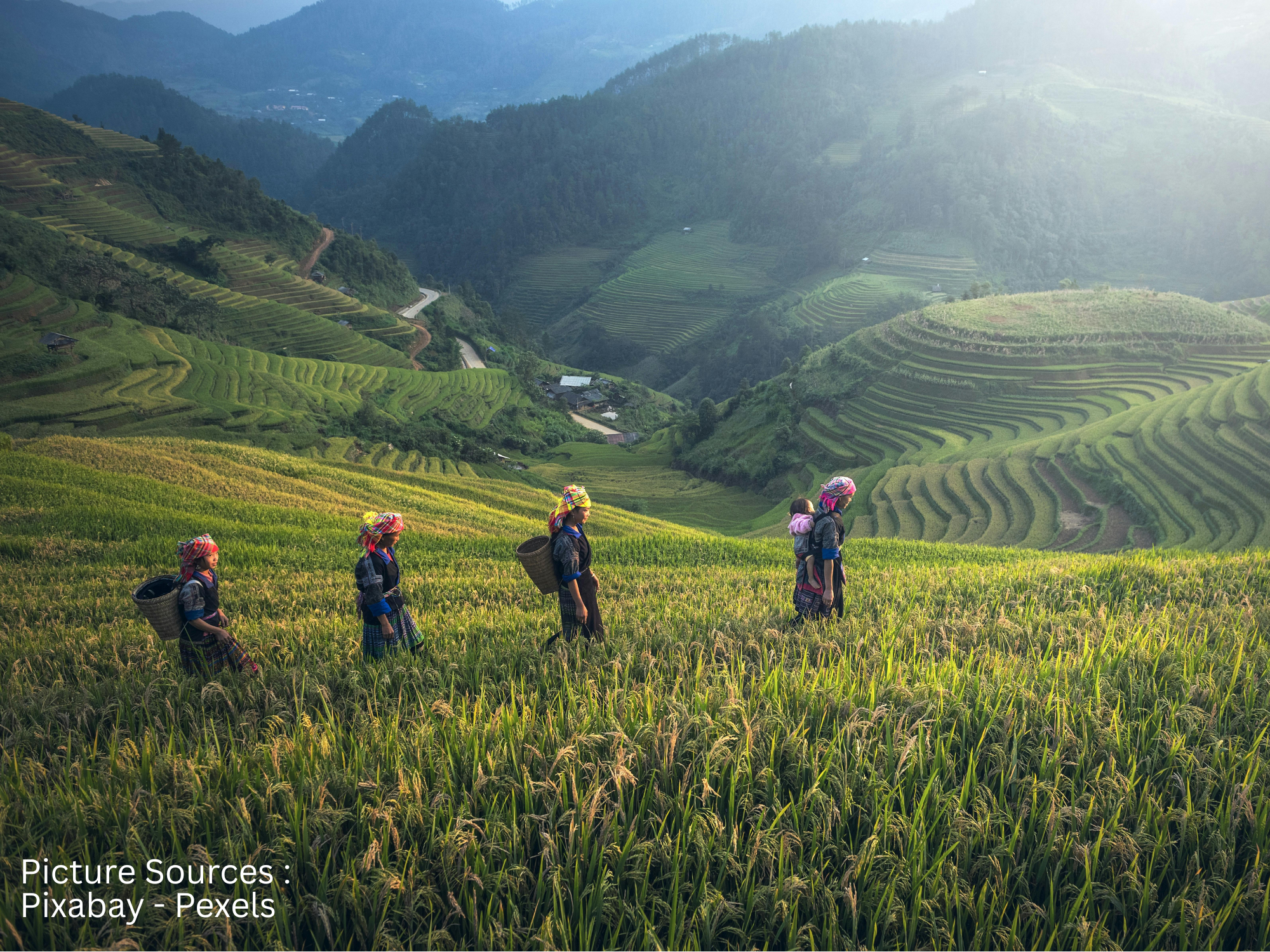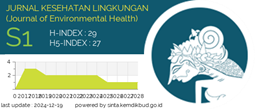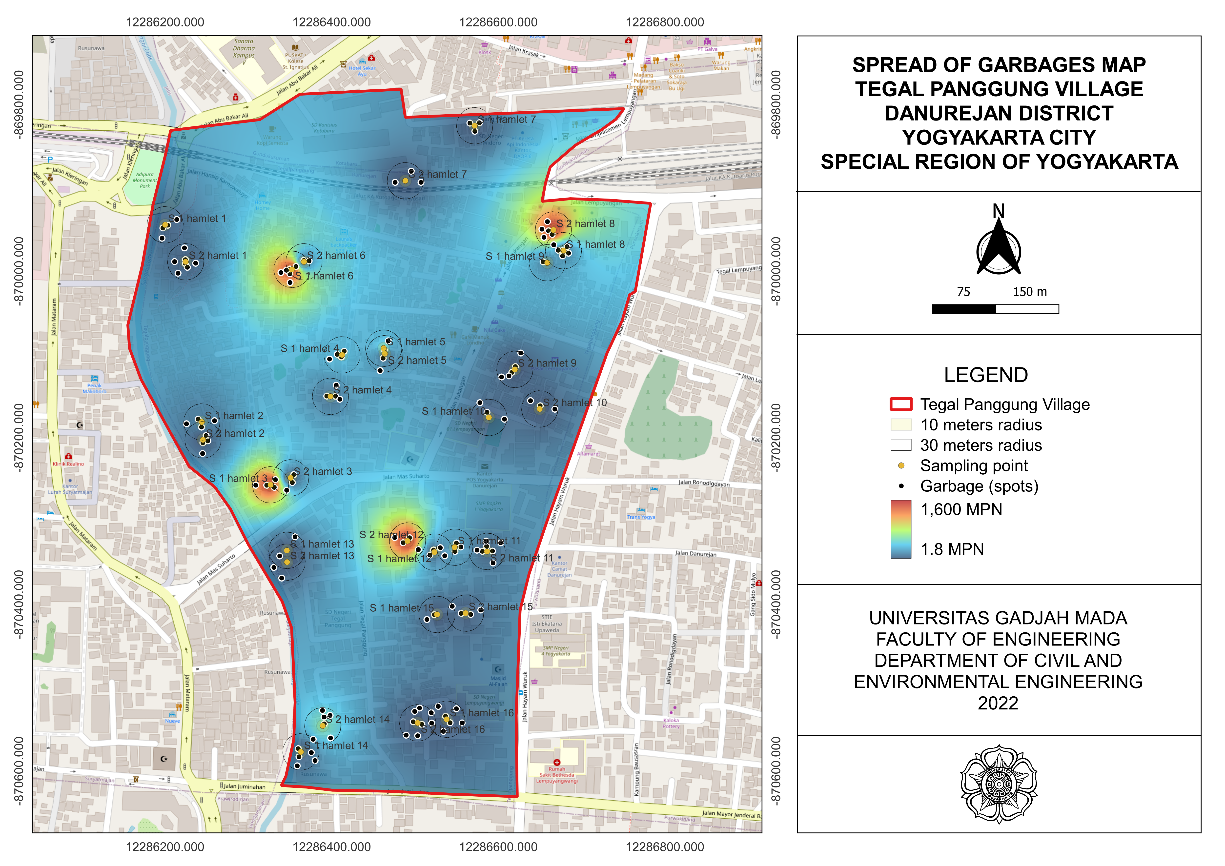Association Between Pesticide Exposure and Type 2 Diabetes Mellitus Among Female Farmers: A Cross-Sectional Study

Introduction: The widespread use of pesticides in agriculture has been linked to an increased risk of diabetes mellitus. Long-term exposure to pesticides can disrupt glucose metabolism, trigger insulin resistance, and raise susceptibility to diabetes mellitus. This study investigates the association between pesticide exposure and the incidence of type 2 diabetes mellitus. Methods: This analytical observational study with a cross-sectional design involved 162 female farmers selected by purposive sampling from a population of 2,187, using the Lemeshow formula. Independent variables included work duration, types and frequency of pesticide use, spraying duration and direction, PPE usage, and cholinesterase levels. The dependent variable was type 2 diabetes mellitus. Data were collected through questionnaires, observation, and clinical tests for blood glucose and cholinesterase levels. Logistic regression was performed at 95% CI and α = 0.05. Result and Discussion: The results showed that 69.1% of female farmers exposed to pesticides had diabetes with lower cholinesterase levels as a significant indicator (p<0.001; OR=3.897; 95% CI=2.087-7.277). Factors such as working duration ≥10 years (p=0.010; OR=3.564; 95% CI=1.359-9.346), number of pesticides types (p=0.023; OR=3.370; 95% CI=1.187-9.570), spraying duration (p=0.020; OR=3.083; 95% CI=1.197-7.940), and PPE usage (p=0.007; OR=3.601; 95% CI=1.416-9.159) were associated with type 2 diabetes mellitus. Conclusion: Pesticides, particularly organophosphates and carbamates, act as endocrine-disrupting chemicals that impair pancreatic function and increase oxidative stress, contributing to insulin resistance. Female farmers more vulnerable to these effects due to hormonal sensitivity, making gender specific approaches essential. Strict regulations and farmer education are crucial to reduce long-term health risks.
Ismail L, Materwala H, Al KJ. Association of Risk Factors with Type 2 Diabetes: A Systematic Review. Computational and Structural Biotechnology Journal. 2021;19:1759–1785. https://doi.org/10.1016/j.csbj.2021.03.003
Jayaraman S, Krishnamoorthy K, Prasad M, Veeraraghavan VP, Krishnamoorthy R, Alshuniaber MA, et al. Glyphosate Potentiates Insulin Resistance in Skeletal Muscle Through the Modulation of IRS-1/PI3K/Akt Mediated Mechanisms: An In Vivo and In Silico Analysis. International Journal of Biological Macromolecules. 2023;242:1–17. https://doi.org/10.1016/j.ijbiomac.2023.124917
International Diabetes Federation. Diabetes. Brussels: International Diabetes Federation; 2021. https://www.diabetesatlas.org/data/en/indicators/19/
World Health Organization. Diabetes. Geneva: World Health Organization; 2023. https://www.who.int/news-room/fact-sheets/detail/diabetes
Dinas Kesehatan Jawa Tengah. Profil Kesehatan Provinsi Jawa Tengah Tahun 2019. Semarang; 2019.https://dinkesjatengprov.go.id/v2018/dokumen/profil2019/mobile/index.html#p=1
Semarang Regency Statistics Agency. Semarang Regency Health Profile. 2022. https://semarangkab.bps.go.id/id/publication/2023/12/27/562cdda445b531ee99992575/
Socea B, Silaghi A, Rebegea LF, Balan DG, Balalau C, Tenea-Cojan T, et al. Diabetes Mellitus: Interdisciplinary Medical, Surgical and Psychological Therapeutic Approach. Journal of Mind and Medical Sciences. 2023;10(2):217–236. https://doi.org/10.22543/2392-7674.1445
Pop-Busui R, Januzzi JL, Bruemmer D, Butalia S, Green JB, Horton WB, et al. Heart Failure: An Underappreciated Complication of Diabetes. A Consensus Report of the American Diabetes Association. Diabetes Care. 2022;45(7):1670–1690. https://doi.org/10.2337/dci22-0014
Toi PL, Anothaisintawee T, Chaikledkaew U, Briones JR, Reutrakul S, Thakkinstian A. Preventive Role of Diet Interventions and Dietary Factors in Type 2 Diabetes Mellitus: An Umbrella Review. Nutrients. 2020;12(9):1–17. https://doi.org/10.3390/nu12092722
Aminov Z, Carpenter DO. Serum Concentrations of Persistent Organic Pollutants and the Metabolic Syndrome in Akwesasne Mohawks, a Native American Community. Environmental Pollution. 2020;260(114004) :1 – 8. https://doi.org/10.1016/j.envpol.2020.114004
Juntarawijit C, Chaichanawirote U, Yaowapanon N, Noppakun K. Pesticide Exposure and Sleep Disorder: A Cross-sectional Study Among Thai Farmers. Heliyon. 2025;11(1). https://doi.org/10.1016/j.heliyon.2024.e41123
Guo X, Wang H, Song Q, Li N, Liang Q, Su W, et al. Association Between Exposure to Organophosphorus Pesticides and the Risk of Diabetes Among US Adults: Cross-Sectional Findings from the National Health and Nutrition Examination Survey. Chemosphere. 2022;301(134471):1–9. https://doi.org/10.1016/j.chemosphere.2022.134471
Paoli M De, Zakharia A, Werstuck GH. The Role of Estrogen in Insulin Resistance A Review of Clinical and Preclinical Data. Am J Pathol. 2021;191(9):1490–1498. https://doi.org/10.1016/j.ajpath.2021.05.011
Food and Agriculture Organization (FAO). Pesticide Use and Trade 1990–2022. Rome: Food and Agriculture Organization of the United Nations; 2024. https://www.fao.org/statistics/highlights-archive/highlights-detail/pesticides-use-and-trade-1990 2022/en#:~:text=Between%201990%20and%202022%2C%20pesticides,per%20person%20by%2035%20percent.
Food and Agriculture Organization (FAO). FAOSTAT Statistical Database. Rome: Food and Agriculture Organization of the United Nations; 2020. https://www.fao.org/faostat/en/#data
Food and Agriculture Organization (FAO). The State of Food and Agriculture: Leveraging Food Systems for Inclusive Rural Transformation. Rome: Food and Agriculture Organization of the United Nations; 2020. https://www.fao.org/state-of-food-agriculture
Ministry of Agriculture of the Republic of Indonesia. Indonesia Pesticide Statistics 2020–2021. Jakarta: Ministry of Agriculture of the Republic of Indonesia; 2022. https://satudata.pertanian.go.id/assets/docs/publikasi/BUKU_STATISTIK_PERTANIAN_2021.pdf
Ministry of Health of the Republic of Indonesia. Health Impact Report on Pesticides in Indonesia. Jakarta: Ministry of Health of the Republic of Indonesia; 2022. https://repository.badankebijakan.kemkes.go.id/4519/1/Basic_Health_Research_Riskesdas.pdf
Miranda RA, Silva BS, de Moura EG, Lisboa PC. Pesticides as Endocrine Disruptors: Programming for Obesity and Diabetes. Endocrine. 2022;79(3):437–447. https://doi.org/10.1007/s12020-022-03229-y
Al-Abdulla R, Ferrero H, Soriano S, Boronat-Belda T, Alonso-Magdalena P. Screening of Relevant Metabolism-Disrupting Chemicals on Pancreatic β-Cells: Evaluation of Murine and Human In Vitro Models. International Journal of Molecular Sciences. 2022;23(8):1–29. https://doi.org/10.3390/ijms23084182
Hansen MRH, Gyawali B, Neupane D, Jørs E, Sandbæk A, Kallestrup P, et al. Pesticide Exposure and Diabetes Mellitus in a Semi-Urban Nepali Population: A Cross-Sectional Study. International Archives of Occupational and Environmental Health. 2020;93(4):513–524.https://doi.org/10.1007/s00420-019-01508-2
Seesen M, Lucchini RG, Siriruttanapruk S, Sapbamrer R, Hongsibsong S, Woskie S, et al. Association Between Organophosphate Pesticide Exposure and Insulin Resistance in Pesticide Sprayers and Nonfarmworkers. International Journal of Environmental Research and Public Health. 2020;17(21):1–13. https://doi.org/10.3390/ijerph17218140
International Diabetes Federation. IDF Diabetes Atlas 2025. Brussels: International Diabetes Federation; 2025. https://diabetesatlas.org/resources/idf-diabetes-atlas-2025/
Sormin MH, Saftarina F, Sudjarwo S. Relationship Between Pesticide Exposure and Type 2 Diabetes Mellitus in Farmers: Systematic Review. International Journal of Current Science Research and Review. 2023;06(06):3400–3407. https://doi.org/10.47191/ijcsrr/V6-i6-32
Sari IP, Suhartono S, Darundiati YH. Pajanan Pestisida Sebagai Faktor Risiko Kejadian Diabetes Mellitus Pada Petani: Sebuah Kajian Sistematik. Jurnal Kesehatan Masyarakat (Undip). 2021;9(4):438–447. https://doi.org/10.14710/jkm.v9i4.29688
Chen T, Liu X, Zhang J, Wang L, Su J, Jing T, et al. Associations of Chronic Exposure to a Mixture of Pesticides and Type 2 Diabetes Mellitus in a Chinese Elderly Population. Chemosphere. 2024;351(141194):1–9. https://doi.org/10.1016/j.chemosphere.2024.141194
Lakshmi J, Mukhopadhyay K, Ramaswamy P, Mahadevan S. A Systematic Review on Organophosphate Pesticide and Type II Diabetes Mellitus. Current Diabetes Reviews. 2020;16(6):586–597. https://doi.org/10.2174/1573399815666190712192844
Zhu X, Chen C, Liu Q, Zhu Z, Wu X, Zhang Y. Multiple Pesticide Exposure and Impaired Glucose Regulation in U.S. Non-Diabetic Population. Environmental Pollution. 2025;366(125519):1–11. https://doi.org/10.1016/j.envpol.2024.125519
Mansouri EH, Reggabi M. Association Between Type 2 Diabetes and Exposure to Chlorinated Persistent Organic Pollutants in Algeria: A Case-Control Study. Chemosphere. 2021;264 (128596):1–9. https://doi.org/10.1016/j.chemosphere.2020.128596
Tyagi S, Mishra BK, Sharma T, Tawar N, Urfi AJ, Banerjee BD, et al. Level of Organochlorine Pesticide in Prediabetic and Newly Diagnosed Diabetes Mellitus Patients with Varying Degree of Glucose Intolerance and Insulin Resistance among North Indian Population. Diabetes & Metabolism Journal. 2021;45(4):558–568. https://doi.org/10.4093/dmj.2020.0093
Pavuk M, Rosenbaum PF, Lewin MD, Serio TC, Rago P, Cave MC, et al. Polychlorinated Biphenyls, Polychlorinated Dibenzo-p-dioxins, Polychlorinated Dibenzofurans, Pesticides, and Diabetes in the Anniston Community Health Survey Follow-up (ACHS II): Single Exposure and Mixture Analysis Approaches. Science of the Total Environment. 2023;877(162920):1–13. https://doi.org/10.1016/j.scitotenv.2023.162920
Parasitekta A, Purwati P, Harningsih T. Pengaruh Lama Penyemprotan terhadap Kadar Enzim Cholinesterase pada Petani Pengguna Pestisida Organofosfat. Jurnal Surya Medika. 2022;8(3):115–119. https://doi.org/10.33084/jsm.v8i3.3296
Vitianoza N, Nurmaini N, Ashar T. Hubungan Indeks Massa Tubuh dan Lama Penyemprotan dengan Diabetes Mellitus Pada Petani di Desa Juhar Ginting Sadanioga Kabupaten Karo. MIRACLE Journal. 2021;1(1):8–13. https://doi.org/10.51771/mj.v1i1.38
Ministry of Manpower of the Republic of Indonesia. Regulation of the Minister of Manpower Number PER-03/MEN/1986 of 1986 About Occupational Safety and Health in Places that Manage Pesticides. Jakarta: Ministry of Manpower of the Republic of Indonesia; 1986. https://indohes.com/wp-content/uploads/2020/07/Permenaker-No.-3-Tahun-1986.pdf
Wei Y, Wang L, Liu J. The Diabetogenic Effects of Pesticides: Evidence Based on Epidemiological and Toxicological Studies. Environmental Pollution. 2023;331(121927):1–20. https://doi.org/10.1016/j.envpol.2023.121927
Yushananta P, Melinda N, Mahendra A, Ahyanti M, Anggraini Y. Faktor Risiko Keracunan Pestisida Pada Petani Hortikultura di Kabupaten di Kabupaten Lampung Barat. Ruwa Jurai: Jurnal Kesehatan Lingkungan. 2020;14(1):1–8. https://doi.org/10.26630/rj.v14i1.2138
Siregar DMS. Faktor yang Berhubungan dengan Kadar Cholinesterase Darah Pekerja Bagian Penyemprotan PT. Anglo Eastern Plantions. Jurnal Mutiara Kesehatan Masyarakat. 2021;6(1):1–9. https://doi.org/10.51544/jmkm.v6i1.1917
OSHA. Personal Protective Equipment. USA: U.S. Department of Labor; 2023. https://www.osha.gov/sites/default/files/publications/OSHA3151.pdf
FAO, WHO. Guidelines for Personal Protection When Handling and Applying Pesticide – International Code of Conduct on Pesticide Management. Rome: Food and Agriculture Organization of the United Nations; 2020. https://openknowledge.fao.org/handle/20.500.14283/ca7430en
Sookhtanlou M, Allahyari MS. Farmers’ Health Risk and the Use of Personal Protective Equipment (PPE) During Pesticide Application. Environmental Science and Pollution Research. 2021;28(22):28168–28178. https://doi.org/10.1007/s11356-021-12502-y
Lari S, Yamagani P, Pandiyan A, Vanka J, Naidu M, Senthil Kumar B, et al. The Impact of the Use of Personal-Protective-Equipment on the Minimization of Effects of Exposure to Pesticides Among Farm-Workers in India. Frontiers in Public Health. 2023;11:1–17. https://doi.org/10.3389/fpubh.2023.1075448
Chung YL, Hou YC, Wang IK, Lu KC, Yen TH. Organophosphate Pesticides and New-Onset Diabetes Mellitus: From Molecular Mechanisms to a Possible Therapeutic Perspective. World Journal of Diabetes. 2021;12(11):1818–1831. https://doi.org/10.4239/wjd.v12.i11.1818
Montgomery H, Morgan S, Srithanaviboonchai K, Ayood P, Siviroj P, Wood MM. Correlates of Health Literacy among Farmers in Northern Thailand. International Journal of Environmental Research and Public Health. 2020;17(19):1–14. https://doi.org/10.3390/ijerph17197071
Nuryati A, Rahardjo SS, Murti B. Pesticide Exposure and Its Correlation with Hemoglobin and Cholinesterase in Farmers Who Used Pesticide. Journal of Epidemiology and Public Health. 2022;7(3):380–396. https://doi.org/10.26911/jepublichealth.2022.07.03.10.

This work is licensed under a Creative Commons Attribution-NonCommercial-ShareAlike 4.0 International License.
1. Copyright of all journal manuscripts is held by the Jurnal Kesehatan Lingkungan.2. Formal legal provisions to access digital articles of electronic journal are subject to the provision of the Creative Commons Attribution-ShareAlike license (CC BY-NC-SA), which means that Jurnal Kesehatan Lingkungan is rightful to keep, transfer media/format, manage in the form of databases, maintain, and publish articles.
3. Published manuscripts both printed and electronic are open access for educational, research, and library purposes. Additionally, the editorial board is not responsible for any violations of copyright law.
JKESLING by UNAIR is licensed under a Creative Commons Attribution-ShareAlike 4.0 International License.







































